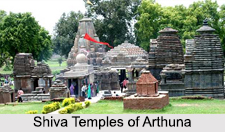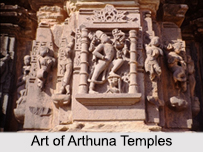 The state of Rajasthan is known for its history, culture and diversity and of the main components which represent the cultural heritage of the state are its temples and monuments. The southernmost part of the state comprised of tribal districts such as that of the Banswara and Dungarpur. The small town of Arthuna is located in the Banswara district of Rajasthan and is known for the clusters of ruined Hindu and Jain temples belonging to the 11th, 12th and 15th centuries.
The state of Rajasthan is known for its history, culture and diversity and of the main components which represent the cultural heritage of the state are its temples and monuments. The southernmost part of the state comprised of tribal districts such as that of the Banswara and Dungarpur. The small town of Arthuna is located in the Banswara district of Rajasthan and is known for the clusters of ruined Hindu and Jain temples belonging to the 11th, 12th and 15th centuries.
History of Arthuna
Formerly known as Amrawati or Utthunaka, the town of Arthuna once used to be the capital of the Parmara rulers of Vagada between the 11th to 12th centuries AD. The rulers patronized both Jainism and Shaivism simultaneously; hence they constructed a number of Shiva temples. An inscription of the Paramara prince Chamundaraja records that he built a temple of Lord Shiva called Mandalesa in honour of his father in 1079 AD. Another inscription dated 1080 AD narrates that his officer`s son named Anantapala also constructed a temple of Shiva.
 Temples of Arthuna
Temples of Arthuna
The cluster of temples found here in Arthuna is split into several complexes and throw light upon the religious beliefs of the rulers. The structures here exhibit a mixture of Shaivism, Jainism and Vaishnavism. In the year 1954, the Archaeological Survey of India began its excavations here which threw light on the existence of the various temple complexes.
As per the inscription of 1080 AD, the Shiva temple of Mandaleshwar is one of the most important and largest Hindu temples in the area constructed by Raja Chamundaraj in the memory of his father, Raja Mandalik. The temple is well protected and the locals regularly visit the temple and offer prayers. Close by is another shrine dedicated to Lord Hanuman, known as the Arthuniya Hanuman Temple built under the patronage of Raja Vijayraj in 1107 AD. Another important temple in this cluster is the Someshwar Mahadev temple where one can see the stone carvings of Shiva Tandava, Andhak Vadh, and Goddess Chamunda. Then there are the Jain temple complex built during the 12th century, close to which are the shrines dedicated to Chausath Yogi and Lord Shiva. As the temples were constructed at different spans of time in a different era, they were all built together in groups. The Hanuman Garhi complex is one such structure which houses a black stone statue of Hanuman along with a shrine dedicated to Lord Shiva.
All these temple complexes followed the Nagara style of architecture, which was prevalent at that point. The temples have a base which was either an elevated square or a rectangular platform on which the main temple was built. The main gate of the temple was followed by a garbhagriha and the top part of the shrine was covered with a metallic cover known as Kalash.
Visiting Information on Arthuna
The ideal time to visit the small temple town of Arthuna is between the months of September and March. Arthuna is located at a distance of 55 km from Banswara and 150 km from Udaipur. The Banswara railway station is the closest as a distance of 45 km from the town and the Maharana Pratap Airport of Udaipur is the nearest at a distance of more than 160 km from the town of Arthuna. The place is well connected via roadways across the state and also to the neighbouring state of Gujarat.



















